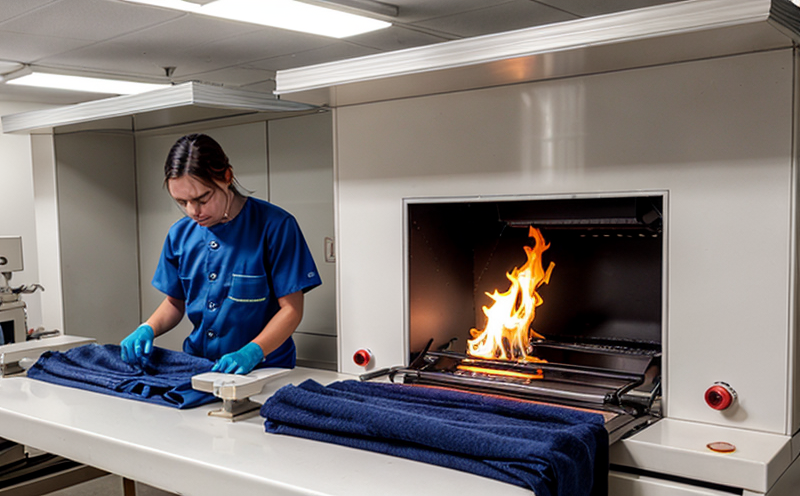ISO 9151 Determination of Burning Behaviour of Textiles
The ISO 9151 standard provides a comprehensive method for determining the burning behaviour of textiles, which is crucial for ensuring safety in various sectors including home furnishings, apparel manufacturing, and automotive interiors. This standard assesses how textiles react to fire under controlled conditions, thereby helping manufacturers ensure compliance with local and international regulations.
The testing procedure involves exposing textile samples to a controlled flame source and monitoring their behavior through several key parameters such as ignition time, flame spread rate, melt or drip, and after-flame duration. The results of these tests are used to classify the textiles into different categories based on their flammability performance. This classification helps in selecting appropriate materials for products that will be exposed to fire hazards.
The importance of this test cannot be overstated in sectors where public safety is a paramount concern. For instance, in the home furnishings industry, fabrics used in upholstery and curtains must meet strict flammability standards to prevent fires from spreading rapidly. Similarly, in the automotive sector, textiles used for seat covers need to pass these tests to ensure passenger safety during potential fire incidents.
The procedure outlined in ISO 9151 is designed to mimic real-world conditions as closely as possible while maintaining consistency and reliability across different laboratories. This ensures that results are reproducible and can be compared accurately between various testing facilities worldwide. The standard specifies precise procedures for sample preparation, equipment calibration, and environmental controls to minimize variability.
One of the key aspects of ISO 9151 is its emphasis on repeatability and reproducibility. By providing detailed guidance on every step of the test process, including specimen preparation, flame application, and measurement techniques, this standard ensures consistent results across different laboratories. This consistency is critical for maintaining trust in the testing process and ensuring that products meet safety standards consistently.
Another important feature of ISO 9151 is its adaptability to various types of textiles. Whether it's woven fabrics or knitted materials, the test protocol can be tailored to suit different material characteristics. This flexibility allows for accurate assessment of a wide range of textile samples, ensuring that all products receive appropriate scrutiny.
The standard also includes provisions for post-test analysis and reporting. After each test run, detailed reports are generated that document all relevant data points including ignition time, flame spread rate, melt or drip observations, and after-flame duration. These reports serve as valuable tools for quality control teams who use them to identify areas where improvements can be made.
For those involved in textile production and safety assessment, understanding the nuances of ISO 9151 is essential. It provides a robust framework that ensures textiles are evaluated fairly and consistently across different environments. By adhering to this standard, manufacturers can enhance product safety while also complying with regulatory requirements globally.
Applied Standards
| Standard | Description |
|---|---|
| ISO 9151-1:2018 | Determination of burning behaviour of textiles - Part 1: Cone test. |
| ISO 9151-2:2013 | Determination of burning behaviour of textiles - Part 2: Flaming time. |
| EN 461 | Determination of resistance to charring and flaming spread of fabrics used in clothing for children. |
Benefits
The implementation of ISO 9151 testing offers numerous advantages, particularly for industries dealing with textiles that come into contact with fire hazards. Some key benefits include:
Enhanced safety: By identifying and addressing potential flammability issues early in the design process, manufacturers can significantly reduce risks associated with fires.
Compliance assurance: Adhering to this international standard helps companies meet regulatory requirements set by governments worldwide.
Informed decision-making: Detailed test results provide valuable insights into material performance, guiding choices that balance aesthetics and safety.
Consistency across markets: A standardized testing method ensures uniformity in evaluations, facilitating easier market entry for textile products.
Overall, ISO 9151 plays a vital role in promoting safer textiles by providing reliable data used to improve product design and manufacturing practices.
Quality and Reliability Assurance
Strict adherence to ISO 9151 ensures consistent results regardless of the laboratory performing the test.
The detailed protocol reduces variability, enhancing confidence in the testing process.
Standardized equipment calibration minimizes measurement errors and promotes accurate comparisons between different batches or versions of materials.
Thorough documentation practices ensure that all relevant data points are captured accurately for future reference.
These measures contribute to high-quality outcomes, fostering trust among stakeholders involved in textile development and production.





